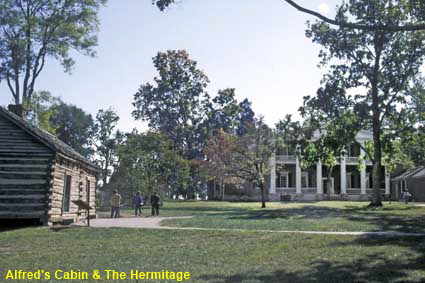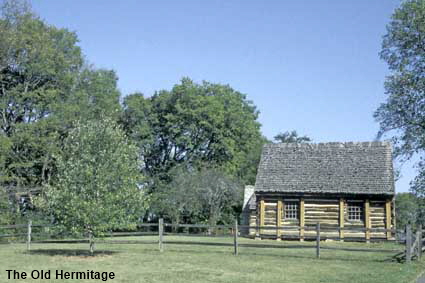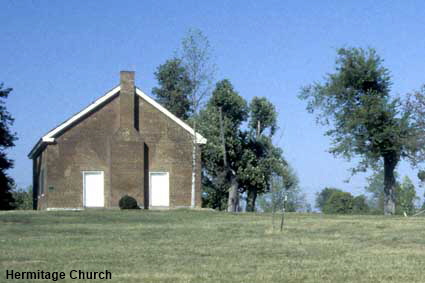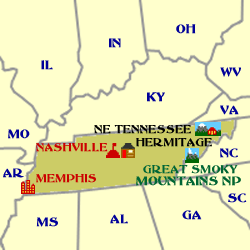The Hermitage was the home of 7th President Andrew Jackson. Born of Irish-Scots parents in the Carolinas in 1767, his father died 3 weeks before his birth. Jackson joined a local militia at the age of 13 to participate in the revolution but in 1781 was captured by the British and treated very badly. He was released as part of a prisoner exchange but later that year was orphaned when his mother died of cholera. In 1787 he began to train as a lawyer and in the 1790s he played an important role in setting up the state of Tennessee. He became a Judge in the state’s Superior Court. In the War of 1812 he joined the army, rising to the rank of General. He defeated the British at the Battle of New Orleans in January 1815 which would have been the greatest US victory of the war but for a peace treaty of which he was unaware signed the previous month. The victory made Jackson a hero, helping him to become US President from 1829 to 1837.
Alfred's Cabin & The Hermitage
Andrew Jackson had a reputation for being rather aggressive and was nicknamed ‘Old Hickory’. He grew cotton on his land, initially with 9 slaves but by 1820 the number had risen to 44. A man of his means needed a better house than the log farmhouse so construction work began in 1819 and the Jacksons moved into their new two storey Federal-style mansion in 1821. A formal garden was added at the same time. In 1834, during Jackson’s time as President, the Hermitage was seriously damaged by fire. It was rebuilt in the Greek Revival-style and was completed in 1836, in good time for Jackson to retire to the Hermitage on leaving office. This picture shows the contrast of the slave cabin and the Hermitage mansion. Born a slave, Alfred Jackson lived in the cabin all of his life, dying a free man in 1901.
The Hermitage
Click on Minimap to navigate
Hermitage Church
In 1823 Andrew Jackson and some of his neighbours donated the money to build a community church. Jackson also donated land for the church and he may have provided slave labour to build it. Jackson joined the church after he retired to the Hermitage. In 1839 the church was completely reconfigured moving the doors from the east to the south side so that it faced the newly completed Lebanon Turnpike. The church continued in use until 1965 when it burned down leaving only the walls standing. The ruin was sold to The Ladies’ Hermitage Association who restored it to its 1839 appearance. The church is occasionally opened to visitors but normally can be viewed only from the outside.
The Old Hermitage
Andrew Jackson’s path to marriage was a little bumpy. In 1788 he met Rachel Donelson Robards whose marriage to Lewis Robards was on the rocks. While Rachel was away visiting friends near Natchez, Jackson heard that Robards had divorced her. He rushed to Natchez and supposedly married her, but Robards had only filed for divorce and he used Rachel’s alleged bigamy to complete the divorce. She married Andrew Jackson legally in 1794. In 1804 a failed venture threatened bankruptcy, so Jackson sold his large riverfront plantation and purchased a more modest farm nearby. He called it ‘The Hermitage’. The original house was a modest two storey log farmhouse. After the mansion was built the log farmhouse was dismantled and used to build two slave cabins, one of which has been preserved.
Andrew Jackson's Grave
Rachel Jackson died suddenly in 1828 and Jackson decided that she should be buried in a crypt in her beloved gardens at the Hermitage. A tomb for both Rachel and Andrew Jackson was designed in 1831 by architect David Morrison. Completed in 1832, it was positioned so that it was visible from both Jackson’s office and his bedroom. After he finished his second term as President in 1837, Andrew Jackson retired to the Hermitage. He died at the Hermitage on June 8, 1845 and two days later ’Old Hickory’ was buried as he had planned alongside his wife.




DLU110603


To move forwards or backwards through the Tennessee trail click the arrows above, or select your next destination on the Minimap.


© Mike Elsden 1981 - 2025
The contents of this page may not be reproduced in full or in part without permission